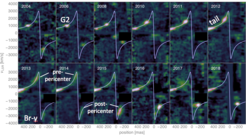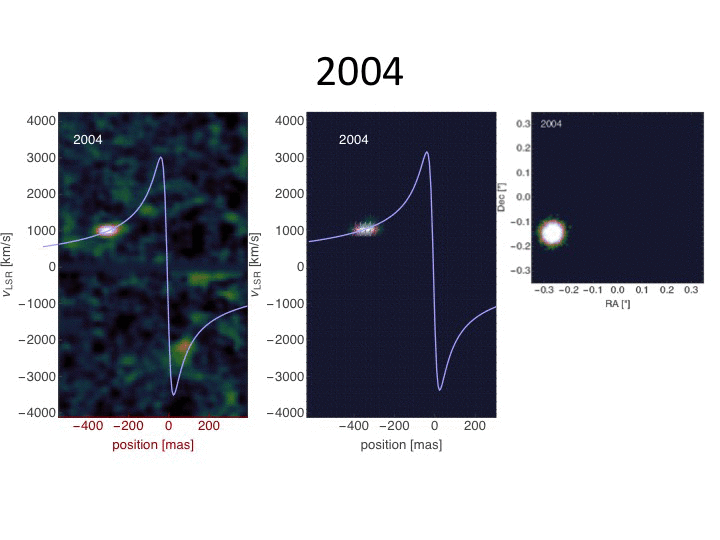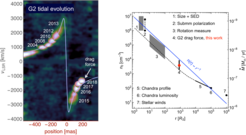The Gas Cloud G2
We detected G2, a dusty, ionized gas cloud on a highly eccentric orbit around Sgr A*, which passed pericenter in spring 2014. The discovery in 2011 was possible due to its dust and recombination line emission (Gillessen et al. 2012). We were able to predict the soon-to-come pericenter passage as well as the tidal disruption, and identified G2 in the data sets ranging back to 2002 (NACO) and 2004 (SINFONI).

The SINFONI data is the most spectacular, and allows us to extract position velocity diagrams along the orbital path. A compilation of such diagrams gives us a detailed overview of how the gravitational force of the MBH has tidally disrupted G2 – this is the first opportunity for scientists to follow and study this process.

Since 2013, we have been able to see how the gas has swirled around the black hole (Gillessen et al. 2013, Pfuhl et al. 2015), with more and more gas moving from the red-shifted side of the orbit that is approaching Sgr A* over to the blue-shifted side. The data are to first order well-described by a simple model consisting only of a cloud of non-interacting test particles – the evolution is thus dominated by the tidal interaction.

The measured radial velocity of G2 in the last years (2016, 2017, 2018) is slower than what the purely Keplerian orbit model predicts. G2 has been slowed down during pericenter passage. This is because G2 was flying through the atmosphere of Sgr A*, the accretion flow from which the black hole is fed. Unlike a star, a gaseous object like G2 is notably affected by the ambient gas density, and loses energy – very much like satellites that can feel the upper part of the Earth's atmosphere. The amount of energy loss can be measured from G2's orbital motion, and allows us to estimate the density of the gas through which it was flying. This yields an estimate of the gas density at around 1,000 Schwarzschild radii, a regime that was previously inaccessible. The accretion flow density was measured previously at around 10 Schwarzschild radii from radio polarization data, and at around 105 Schwarzschild radii from its X-ray emission. Our novel estimate fills the gap in between nicely.

The origin of G2 is debated. The two basic model types are purely gaseous clouds, and models that assume a central star with some circumstellar material. Our preferred model is that G2 is a dense knot in a much longer gas streamer, perhaps a stretched clump of a stellar wind, or the debris from a partial tidal disruption of a giant star that came a bit too close to Sgr A*, since there is more, lower-surface-density gas along the orbital trace.
More information:
- MPE press release A Black Hole's Dinner is Fast Approaching
- MPE press release Ripped Apart by a Black Hole



